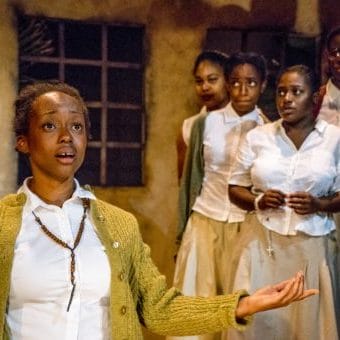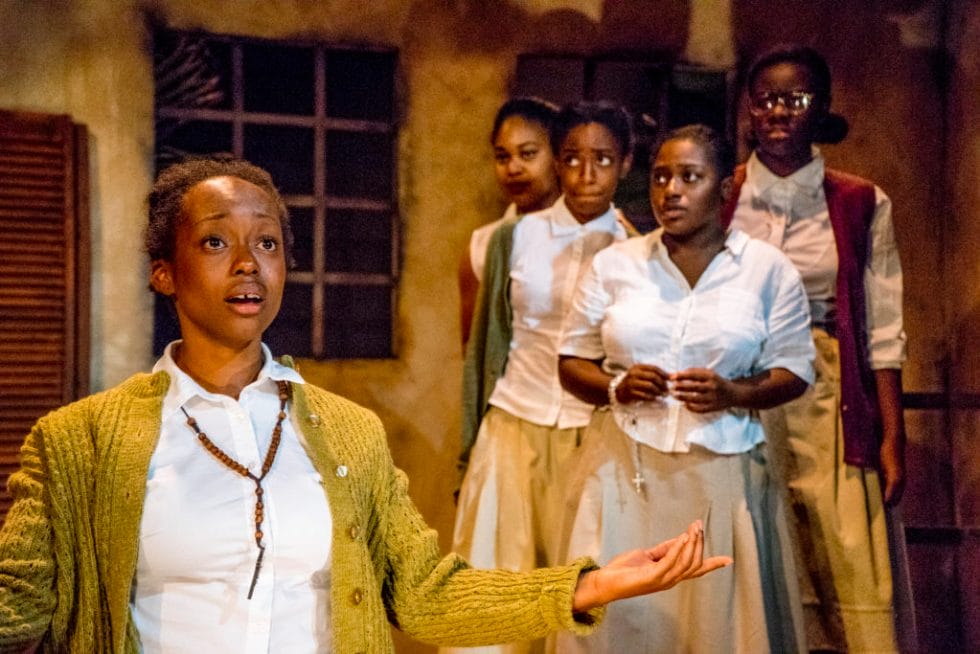Beauty, Faith and Prophecy: A review of Our Lady of Kibeho
By Rebecca Romani
Rwanda, in central/east Africa, is the land of 1,000 hills, the land of majestic mountain gorillas. It is also a land of great faith and deep, deep tragedy – the kind that only a profound inner strength and hard-won grace can overcome.
Katori Hall’s new play, “Our Lady of Kibeho,” only briefly alludes to the horrific genocide that rocked Rwanda in 1994, when one group, the Hutu, took after the other, the Tutsi, with machetes and matches, and slaughtered hundreds of thousands of their fellow Rwandans over a period of 100 days. But when Hall does reference the mass murders, it is a powerful reminder of how faith and humanity can make the mountains mourn.
Hall’s play, currently enjoying a well-attended West Coast premiere run at Moxie Theatre in La Mesa, refers only lightly to the Rwandan Genocide- it is, after all, “Before,” as one title states, but the specter of “after” hangs in the air over the play, giving it an eerie feel, made eerier by the very real story Hall brings to life.
The year is 1981- a full 13 years before the violence that will bring Rwanda to its knees is unleashed. Three teenage girls at Kibeho College, a Catholic girl’s high school, have begun to see apparitions of the Virgin Mary, much to the consternation of the head nun, Sister Mary Evangelique (a solid performance by SD Theatre Critics Circle Award Winner, Yolanda Franklin). The question is, are these teenage fantasies or the real deal?
Cashae Monya plays Alphonsine, a young Tutsi orphan, who first starts to see apparitions of a beautiful woman she claims is the Virgin Mary, come to Kibeho, bringing messages of faith and prophecy.
Monya’s Alphonsine is at turns charming innocent and ecstatic visionary, unsure of why Mary would choose an orphan Tutsi girl who doesn’t really know her catechism, to be the vessel for her words. Mallory Johnson is the perfect foil to Monya’s messenger as Marie Claire, the older girl who torments Alphonsine and her friend Anathalie (played with grace and calm by Tyrah Hunte), until she, too, is chosen to see.
It is Mary Claire’s visions which are the most disturbing- she hears and sees the Virgin’s prophecy- that Rwanda will be consumed by horrific turmoil that will make its famous hills run red if the Hutus and Tutsis don’t work out their differences- and she will be among its victims.
As Alphonsine becomes more convinced of her visions, the charming local priest Father Tuyishime (the magnificent Vimel Sephus) at first worries she is the throes of some teenage hysteria, but then is afraid she’ll bring unwanted attention to the parish, although he, too, is starting to come around.
Only Sister Evangelique, the Hutu head nun of the school stands alone, uncertain, unconvinced and outnumbered. At first, she takes a most un-nunlike tack, encouraging Marie Claire to aggressively unmask the girls as Tutsi charlatans. Later, she begins to wonder, and one hears a deeper sorrow- that of a religious wondering why Mary has chosen to speak through three sometimes disobedient, sometimes under-educated teenagers and not her, her faithful devotee.
Antonio Johnson is a strong Bishop Gahamanyi, an African cleric who senses if not an actual apparition, then at least a religious fervor sure to bring with it the fruits of pilgrims’ desires to a small corner of Rwanda. After all, why should three shepherd children from Fatima in Portugal get all the attention for the very same sort of sightings?
It is to that end that the Vatican sends one Father Flavia (Steve Froehlich) to test the girls and determine if the apparitions can be sanctioned by the Holy See. Froehlich plays Flavia with a sanguine superiority, a European priest who surely wonders, in the words spoken in Italian by Anathalie- how the Virgin could appear to teenage African girls on the outskirts of the jungle.
Director Jennifer Eve Thorn uses a light but clearheaded touch in directing such a dense and multi-leveled play, based as it is, on real events. Divya Murthy Kumar’s sets make great use of the stage, on one side the girls’ quarters, on the other, the school’s offices. Costuming is kept beautifully in hand by Anastasia Pautova whose schoolgirl uniforms contrast nicely with the hodgepodge of looks worn by the villagers.
Both Hall and Thorn keep largely within the remembrances of the Marion apparitions- the name given to visions of the Virgin Mary. Even Emmanuel (solid performance by Imahni KingMurillo) a convert to Christianity who claimed to see Jesus in a bean field, is there, although his presence seems more of a footnote than it was in actuality.
Although the Moxie stage looks little, Props Designer Angelica Ynfante makes good use of Kumar’s ample sets to launch the humble but startling hauntings of beds that buck and other events that finally convince the doubting Sister Evangelique and Father Flavia that something out of the ordinary has come to Kibeho.
Hall, an Olivier-award winning playwright, has done extraordinary research on a difficult subject. She deftly weaves in some of the tensions between the Tutsi, former Kings of Rwanda, and the Hutus, ancient and aggrieved subjects, simmering just below the surface. As Sister Evangelique expresses pride that she, a Hutu, should host a representative of the Vatican, the Bishop reminds Father Tuyishime, that they, as Tutsis, once were kings.
While Hall, has done her homework, Moxie could do a little more. The program notes are very interesting, if not a little incomplete. Although they go into the Genocide, the events that led up to it, and Belgium’s aggressive colonial rule it is also important to know that tensions between Tutsi and Hutu were already there, thanks to Tutsi rule over the Hutus in the 18th century.
And then, there is the issue of accents. Moxie seems to have a thing for accents. When done well, they add additional depth. However, when not, they can be somewhat distracting as in this play where the actors’ accents wander from Jamaica to Johannesburg, and around Africa. Father Flavia’s “Italian” accent frequently places him somewhere in Portugal and then lingers in Southern Europe for a while. In addition, if an actor is going to speak a few lines in a foreign language, those lines need to be spoken clearly and be grammatically correct.
But these things are minor in a play where an unusual true story is told so compellingly and paced so well.
The girls’ visions of horrific events are often interpreted as foretelling the Rwandan Genocide, and Marie Claire’s death happened much as she foresees it. But on a more positive note, Rwandan has made impressive strides in both remembering what happened and in reconciling the population- as the girls also foretold, in festivals also held at the shrine of Our Lady of Kihebo.
As the Nigerian character, Okwe says in the film, “Dirty Pretty Things,” this is an African story…” and one very well told.
“Our Lady of Kibeho” continues this weekend at the Moxie Theatre in La Mesa. The show has done so well, Moxie has added extra shows. Please contact the theatre for times and dates. http://www.moxietheatre.com/shows/our-lady-of-kibeho/




